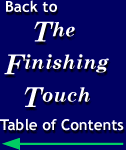

|
|
The Spin Cycle: Plastic
Coil Elements Custom Made at RGS
By Mark Rasch, Vice President
We all know them well. Attractive, professional, durable...FUN!
Available in assorted sizes and colors to match any PMS. We call
them plastic coil elements. The concept is simple. Spin it into a pre-punched
book and your done. Well, not so fast! What about the element? How is it made?
A little history first. Did you know that these elements were not originally intended for bookbinding applications at all? In fact they were actually used by German chicken breeders as leashes to keep their chickens at bay. Odd, isn't it. It wasn't until later that a creative mind conceived the concept of spinning these elements into books to create an innovative new style of binding. By the 1970's this form of binding began to surface at several U.S. manufacturers. Due to its great popularity, it surpassed GBC combs, which used to be the leading form of mechanical binding. This eventually forced General Binding Company to enter the plastic coil market in 1990.
The coil manufacturing process is rather intriguing. It begins with the use of polyvinyl chloride, a petroleum-based clear material sold by large oil manufacturers in pellet form. Otherwise know as PVC plastic, this material is used for many products including PVC pipe, clear water bottles, and even the packaging of your children's toys. The PVC pellets are dumped into an extruder along with pigment to add color. This is then heated and forced through a hole in a metal plate, similar to the process used by your local butcher to grind beef. Ropelike filament is then produced and cooled through a water bath. A friction process is then applied to the filament to mold it down to its final profile. The filament is then spooled in twenty-five pound increments for later use in the forming process.
At Rasch Graphic Services, we use this extruded filament on our Plastkoil Concept QS Interline System to finish out the entire "Spin Cycle." The filament is fed into a mandrel from the twenty-five pound spool and is then heated to help shape the material into a coil. The coil is then cut and fed onto a belt that delivers it into the inserter where it is spun into a pre-punched book. The book is completed when the coil is cut and crimped inline.
With our new QS Interline system, Rasch Graphics offers two options. For those customers who wish to purchase coils only, we offer elements that range from 6mm to 30mm in diameter in a huge assortment of over 45 colors. We even have neon red! For those companies that do not have the time or the resources to do the insertion, Rasch Graphics can turn key the entire project from start to finish.
So, the next time you find yourself in a plastic coil tailspin, remember one thing...with the Spin Cycle, Rasch Graphics is the one to call.
About Rasch Graphics | More
Information
PUR Binding | Perfect
Binding | Saddle Stitching | Mechanical
Binding
Tab Cutting | Support
Services | The Finishing Touch Newsletter
EMail RGS | Home
Page
![]()
![]()
7211 N. Gessner Drive • Houston, TX 77040-3143
Phone: 800 / 713-785-5750 • Fax: 800 / 713-785-5801